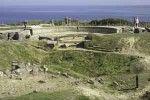On June 6, 1944, now known as D-Day, Lt. Col. James Earl Rudder led the 2nd Ranger Battalion of the United States Army at the Point du Hoc site, as they destroyed five 155-millimeter cannons that were used to fire on U.S. soldiers and ships. Sixty-two years later, researchers from Texas A&M, where Rudder became University president later in life, will return to the site to keep it from falling into the sea.
Professors and student researchers will receive a grant from the American Battle Monuments Commission to preserve the Point du Hoc cliff on Omaha Beach that Rudder and his “Rudder Rangers” scaled during the D-Day invasion. Those involved with the program come from a variety of University departments, including architecture, construction science, geology and geophysics, anthropology, civil engineering and history.
“We will (be) beginning our field work in June at the Point du Hoc site, studying erosion issues on the site, trying to understand what all the erosion factors are and also mapping all of the historic buildings and features of the site, such as the bunkers and the bomb and shell craters and any trenches we see,” said Bob Warden, a professor in the construction science department and a co-principal investigator of the research.
The grant comes from $500,000 in federal funding secured by Rep. Chet Edwards, given to the American Battle Monuments Commission to repair the site. A&M researchers submitted the winning bid for the project and most of the grant will go to the University to fund the project.
“Point du Hoc is hallowed ground that should stand for generations to come as a sacred symbol to the world of the American GI’s unwavering courage in World War II,” Edwards said. “As an Aggie, I know that this project will be a labor of love for Texas A&M, not just another job.”
The cliff’s observation point has been closed to the public since 2001 because of erosion.
“The site contains valuable historic information about the battle and memorial erected by the State of Texas honoring then-Lieutenant Colonel Earl Rudder,” Joshua Taylor, communications director for Edwards, said in an e-mail. “It is critically important to survey the site, identify culturally significant resources and preserve the site for historic remembrance.”
Most of the researchers have worked at the site for several years. When they return in June, it will be the first time under funding by the American Battle Monuments Commission.
“I was reading the Rudder’s Rangers’ book and was surprised to find that there were no maps or drawing of the site,” said Richard Burt, a construction science professor and co-principal investigator. “We realized the site was still there and that nobody had done a study of it. With the connection of us and Col. Rudder we thought it would be important for us to do that.”
The project has grown every year, Burt said.
“The original intent was to record the site for posterity and be able to tell the story full…now we are doing some work this summer, which is really a study of the cliff base to see how fragile and stabile it is and if it is in danger,” he said.
In addition to the professors, 12 students will participate in the research.
“We have students involved every year,” Burt said. “They do much of the measuring work. We use them for the geophysics. And they do most of the drawing. They do most of the work and we take most of the credit for them.”
Profs, students to restore battle site
April 20, 2006

Donate to The Battalion
Your donation will support the student journalists of Texas A&M University - College Station. Your contribution will allow us to purchase equipment and cover our annual website hosting costs.



















